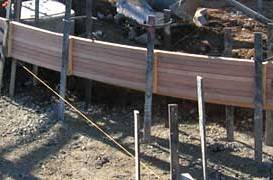Foundations for Straw Bale houses - Tip to Save Your Concrete Stakes
Why Protecting Your Stakes Matters in Straw Bale Foundations
When pouring foundations for straw bale houses, there's one commonly overlooked item that can quietly eat into your budget: concrete stakes.
These simple metal or wood stakes are critical to holding your form boards in place during the pour—but if you’re not careful, you’ll end up with dozens of them trapped in concrete, never to be used again.
Let’s break down how to avoid that mistake with one simple, low-cost solution.
💸 How Much Are You Losing in Trapped Stakes?
Each concrete stake can cost $6 or more, and a typical foundation pour may require over 200 stakes. That adds up fast in materials—some of which might end up sealed permanently inside your slab.
Why does this happen?
Even though stakes are placed outside the form boards, concrete can flow underneath and around them. Once the concrete sets, you’re stuck—literally.
⚠️ The Problem: Gaps at the Bottom of the Form
Even tiny gaps between the form board and the ground allow concrete to ooze out and wrap around the stakes.
If you don’t catch it in time, you won’t be able to remove the stake. That’s a permanent loss—not to mention a potential weak spot or inconsistency in your foundation.
✅ The Simple Fix: Foam Pipe Insulation
Instead of trying to plug every leak during your pour (a losing battle), there’s a better solution: foam pipe insulation.
Here’s how it works:
Cut pieces of foam insulation to fit snugly between the stake, the ground, and the underside of the form board
Install in seconds with a razor knife
The foam prevents concrete from wrapping around the stake
Once the pour sets, you can pull the stake easily, leaving only a tiny piece of foam in the concrete
For less than a dollar in foam, we saved a $6 stake and kept the foundation clean and strong.
Real-World Example: Supporting a Floating Form
In one project, we needed to float a form board over a widened footing—meaning we had to place a stake right in the middle of the footer. Without protection, I’d have lost that stake.
Instead, we used scrap foam to isolate the stake. After the concrete cured, we pulled the stake with no trouble, leaving a tiny plug of foam behind—harmless to the strength of the structure.
💡 Why This Matters for Straw Bale Foundations
If you're building a straw bale house, your foundation is critical. Whether you're pouring a slab, stem wall, or hybrid system, every component should be durable, efficient, and cost-effective.
Small steps like this don’t just save money—they protect your workflow, reduce frustration, and reinforce good building habits from the ground up.
Want to Learn More About Foundations for Straw Bale Houses?
There’s a lot more to building with bales than just stacking straw. Start from the ground up with confidence by learning proven techniques from experienced builders and get started for free today.
Updated: July 11, 2025




